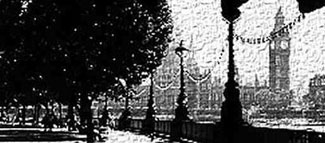|

|
||||
Susanne Cuevas, Babylon and Golden City: Representations of London in Black and Asian British Novels since the 1990s. (Heidelberg, Universitätsverlag Winter, 2008.), pbk, ISBN: 9783825354688, 30 Euros.
Susan Alice Fischer
<1> Susanne Cuevas’s Babylon and Golden City: Representations of London in Black and Asian British Novels since the 1990s is a well-researched book containing useful information for both the scholar and student of contemporary British literature, specifically that by Black and Asian novelists whose work is set in London. The author contextualises her subject within the histories of London literature and of Black and Asian British literature. She also provides a rich digest of statistics stemming mostly from the 2001 Census as well as an overview of important moments in London’s recent history of race relations. Including this accessibly written book on a course reading list would benefit students’ understanding not only of recent Black and Asian novels, but also of the cultural and historical contexts from which they emerge.
<2> Following this background material, Cuevas begins to home in on her exploration of contemporary Black and Asian representations of London by reviewing recent theoretical considerations of urban space and the global city, with particular reference to ethnicity and to some degree gender. Here and in ensuing chapters, Cuevas organises her material by considering interactions between urban space and ethnicity. She justifiably critiques ‘classic’ theorists who focused on white, male, middle-class and heterosexual experiences of urban space and reviews more recent formulations including the global city, transnationalism and diasporic and national identity.
<3> In her theoretical discussion, Cuevas rightly centres on ‘visible minorities’—whom she defines exclusively as Black and Asian—as they are much more likely to encounter discrimination and outright violence in city (and other) spaces. A rather more nuanced theorisation of ‘visible minority’ would have avoided discounting gays, lesbians and Jews on the grounds that they can ‘choose’ to ‘pass’. Indeed this is not always the case, and some Black and Asian people can ‘hide’ their ethnicity. While the categories of ‘colour’ or ‘race’ as constructed in contemporary London—and in so many other parts of the world—are frequently the most flagrantly used way of dividing, segregating, discriminating against, harassing and even killing people, the concept of ‘visibility’ is somewhat more fluid than Cuevas makes out. However, these are but minor quibbles with a thorough review of what it means to enter or occupy space in a city and a world that persistently and viciously marks black and brown bodies as other.
<4> Discussion of the novels themselves gets thoroughly underway in Chapter 5. Cuevas discusses Mark Stein’s definition of Black British novels of formation as ‘transformative’ (see his Black British Literature: Novels of Transformation (Ohio State University, 2004)) and critiques the usefulness of the original German formulation of the Bildungsroman, which stressed the ‘harmonious’ ‘unfolding’ of the individual ‘in a benevolent society’ (Cuevas, p. 94). Cuevas rightly points out that this runs counter to the experiences represented in contemporary Black British novels of development, where things don’t always end satisfactorily for protagonists coming of age in a racist society. She thus prefers the term ‘novel of formation’.
<5> Here the author intelligently examines three novels -- Atima Srivastava’s Transmission, Diran Adebayo’s Some Kind of Black and Bernadine Evaristo’s Lara -— within the context of the ways the characters interact with the spaces of home, street, pubs, clubs and parties, schools and universities—as they make their way into adulthood and develop a sense of ‘homeland’, ‘real or imaginary’. That is, the spatial trajectory from a conflicted sense of ‘home’ or belonging, through urban spaces, ultimately comes full circle as the protagonists assess their place in London life and develop diasporic identities and redefine Englishness. What makes this chapter particularly rich is not only the analysis of the texts, but the background information on contemporary London history, from Thatcher’s stop and search (sus) laws and the New Cross fire to the experiences of Black and Asian youth in education, all of which elucidates references in the novels and provides a valuable resource for further reading.
<6> In chapter 6, Cuevas examines the ways that contemporary Black and Asian British writers have experimented with different forms, from the thriller or detective story (Diran Adebayo’s My Once Upon a Time) and the ‘revisionist’ history (Bernadine Evaristo’s The Emperor’s Babe) to the novel of modern urban life (Zadie Smith’s White Teeth). In Chapter 7, she explores what she refers to as the ‘return’ of the realistic novel (Monica Ali’s Brick Lane and Courttia Newland’s The Scholar: A Westside Story). The ‘return’ Cuevas refers to is an updated version of novels by earlier Black and Asian writers, such as Sam Selvon, Buchi Emecheta and Joan Riley, who focused on the struggles of impoverished and marginalised Londoners and denounced the injustices they encountered. Books such as Brick Lane, of which Cuevas offers an interesting reading, highlight the struggle of a new generation of migrants to London.
<7>
Cuevas’s book is notable for many things, not least of which is an unusually equitable balance between male and female authors. One of the best things about this book is the constant reference to the social, historical and political contexts of the London novels examined here. This makes for a text rich in information, as well as intelligent interpretation, and one that offers the curious reader many resources for further study.
To Cite This Article:
Susan Alice Fischer, ‘Review of Susanne Cuevas, Babylon and Golden City: Representations of London in Black and Asian British Novels since the 1990s. (Heidelberg, Universitätsverlag Winter, 2008.)’. Literary London: Interdisciplinary Studies in the Representation of London, Volume 7 Number 1 (March 2009). Online at http://www.literarylondon.org/london-journal/march2009/fischer1.html.
All material published in The Literary London Journal (material within the directory www.literarylondon.org/london-journal/) is copyright © the identified author. If no author is identified in relation to content, that content is copyright © The Literary London Society, 2003-2014.